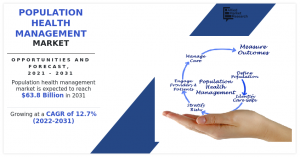Population Health Management Market: A Strategic Shift in Global Healthcare
Get a Sample Copy of this Report: https://www.alliedmarketresearch.com/request-sample/2022
Population health management PHM is the process of improving the health outcomes of a group of individuals through better care coordination and patient engagement. The key principle behind PHM is the proactive rather than reactive delivery of healthcare services, emphasizing prevention, early intervention, and continuous monitoring. It involves the use of advanced data analytics and clinical tools to gather, analyze, and interpret data from multiple sources for decision-making and optimized healthcare delivery.
Key Market Drivers
Rising elderly population increasing demand for chronic care services and long-term monitoring
Higher healthcare expenditure per person across developed and emerging nations
Integration of IoT in healthcare with smart devices enabling remote monitoring and real-time data exchange
Growth in personalized medicine supported by artificial intelligence and predictive analytics
Increased healthcare investments by governments and private players in data-driven health systems
Barriers and Challenges
Concerns around data privacy and breaches
High initial investment cost in deploying PHM solutions and training staff
Limited interoperability among legacy systems across healthcare providers
Market Opportunities
Development of cost-effective and scalable solutions
Rise in strategic collaborations between tech firms and healthcare providers
Government initiatives supporting digital health transformation
Advancements in cloud computing and secure data hosting platforms
Market Segmentation Insights
By Component:
Software held the largest market share in 2021 and is projected to grow at a CAGR of 13.2 percent
Demand is driven by enhanced operational efficiency and frequent product innovation
By Mode of Delivery:
On-premise systems dominated the market in 2021 due to better control over data security and system customization
Cloud-based solutions expected to record the highest growth rate of 13.3 percent due to easier access and scalability
By End User:
Healthcare providers were the primary users in 2021 due to rising adoption in hospitals and clinics
Healthcare payers projected to grow fastest at 13.8 percent CAGR due to direct integration with insurers and removal of third-party bottlenecks
Regional Overview
North America dominated the market in 2021 due to:
Strong digital health infrastructure
Presence of major PHM vendors
Favorable reimbursement policies
Asia-Pacific is expected to grow at the highest rate owing to:
Expanding healthcare infrastructure
Aging population in countries like Japan and China
Government support for tech-driven public health initiatives
Key Market Players
Leading players shaping the global PHM market include:
Allscripts Healthcare Solutions Inc
Arcadia
AthenaHealth Inc
Cotiviti Inc
Epic Systems Corporation
Health Catalyst Inc
IBM Watson Health
Koninklijke Philips NV
Optum Inc a part of UnitedHealth Group
Oracle Cerner
These companies are actively investing in product development, strategic partnerships, and AI integration to gain a competitive edge.
Key Takeaways
Population health management is redefining care delivery with a focus on prevention, data integration, and patient engagement
Cloud-based models and software platforms are transforming how data is used to improve health outcomes
As healthcare systems evolve, PHM will play a central role in managing costs and improving long-term clinical outcomes
Quick Highlights
Market size expected to grow from 19.2 billion to 63.8 billion dollars by 2031
Cloud-based solutions and healthcare payers segment are fastest-growing
North America leads the market, while Asia-Pacific presents emerging opportunities
Enquire Before Buying: https://www.alliedmarketresearch.com/purchase-enquiry/2022
David Correa
Allied Market Research
+ 1800-792-5285
email us here
Visit us on social media:
LinkedIn
Facebook
YouTube
X
Legal Disclaimer:
EIN Presswire provides this news content "as is" without warranty of any kind. We do not accept any responsibility or liability for the accuracy, content, images, videos, licenses, completeness, legality, or reliability of the information contained in this article. If you have any complaints or copyright issues related to this article, kindly contact the author above.
Karl Berger Takes Readers into a Desolate Pacific Outpost In His Gripping Novel, 'Clipperton'
A New Thanksgiving Tradition: Uplyft & Dayglo Presents to Host Parade Brunch From the Iconic Jazz at Lincoln Center
The Old Dutch Cupboard Shares Tips on Eating to Reduce Stress and Support Mood Health
Więcej ważnych informacji
 Jedynka Newserii
Jedynka Newserii

 Jedynka Newserii
Jedynka Newserii

Problemy społeczne

Ślązacy wciąż nie są uznani za mniejszość etniczną. Temat języka śląskiego wraca do debaty publicznej i prac parlamentarnych
W Polsce 600 tys. osób deklaruje narodowość śląską, a 460 tys. mówi po śląsku. Kwestia uznania etnolektu śląskiego za język regionalny od lat wzbudza żywe dyskusje. Zwolennicy zmiany statusu języka śląskiego najbliżej celu byli w 2024 roku, ale nowelizację ustawy o mniejszościach narodowych i etnicznych zablokowało prezydenckie weto. Ostatnio problem wybrzmiał podczas debaty w Parlamencie Europejskim, ale zdaniem Łukasza Kohuta z PO na forum UE również trudna jest walka o prawa mniejszości etnicznych i językowych.
Transport
Polacy z niejednoznacznymi opiniami na temat autonomicznych pojazdów. Wiedzą o korzyściach, ale zgłaszają też obawy

Polacy widzą w pojazdach autonomicznych szansę na poprawę bezpieczeństwa na drogach i zwiększenie mobilności osób starszych czy z niepełnosprawnościami. Jednocześnie rozwojowi technologii AV towarzyszą obawy, m.in. o utratę kontroli nad pojazdem czy o większą awaryjność niż w przypadku tradycyjnych aut – wynika z prowadzonych przez Łukasiewicz – PIMOT badań na temat akceptacji społecznej dla AV. Te obawy wskazują, że rozwojowi technologii powinna także towarzyszyć edukacja, zarówno kierowców, jak i pasażerów. Eksperci mówią także o konieczności transparentnego informowania o możliwościach i ograniczeniach AV.
Prawo
70 proc. Polaków planuje wyjazd na urlop w sezonie letnim 2025. Do łask wracają wakacje last minute

Ponad 70 proc. Polaków planuje wyjechać na urlop w sezonie letnim, czyli między końcem czerwca a końcem września – wynika z badania Polskiej Organizacji Turystycznej. 35 proc. zamierza wyjechać tylko raz, a 30 proc. – co najmniej dwa razy. Z grupy wyjeżdżających jedna trzecia wybierze się na wyjazd zagraniczny. Jak wskazuje Katarzyna Turosieńska z Polskiej Izby Turystyki, po kilku latach ponownie do łask wracają oferty last minute, a zagraniczne kierunki pozostają niezmienne – prym wiodą m.in. Grecja, Tunezja, Egipt czy Hiszpania.
Partner serwisu
Szkolenia

Akademia Newserii
Akademia Newserii to projekt, w ramach którego najlepsi polscy dziennikarze biznesowi, giełdowi oraz lifestylowi, a także szkoleniowcy z wieloletnim doświadczeniem dzielą się swoją wiedzą nt. pracy z mediami.


![Nestlé w Polsce podsumowuje wpływ na krajową gospodarkę. Firma wygenerowała 0,6 proc. polskiego PKB [DEPESZA]](https://www.newseria.pl/files/1097841585/fabryka-nesquik_1,w_85,r_png,_small.png)






.gif)

 |
| |
| |
|